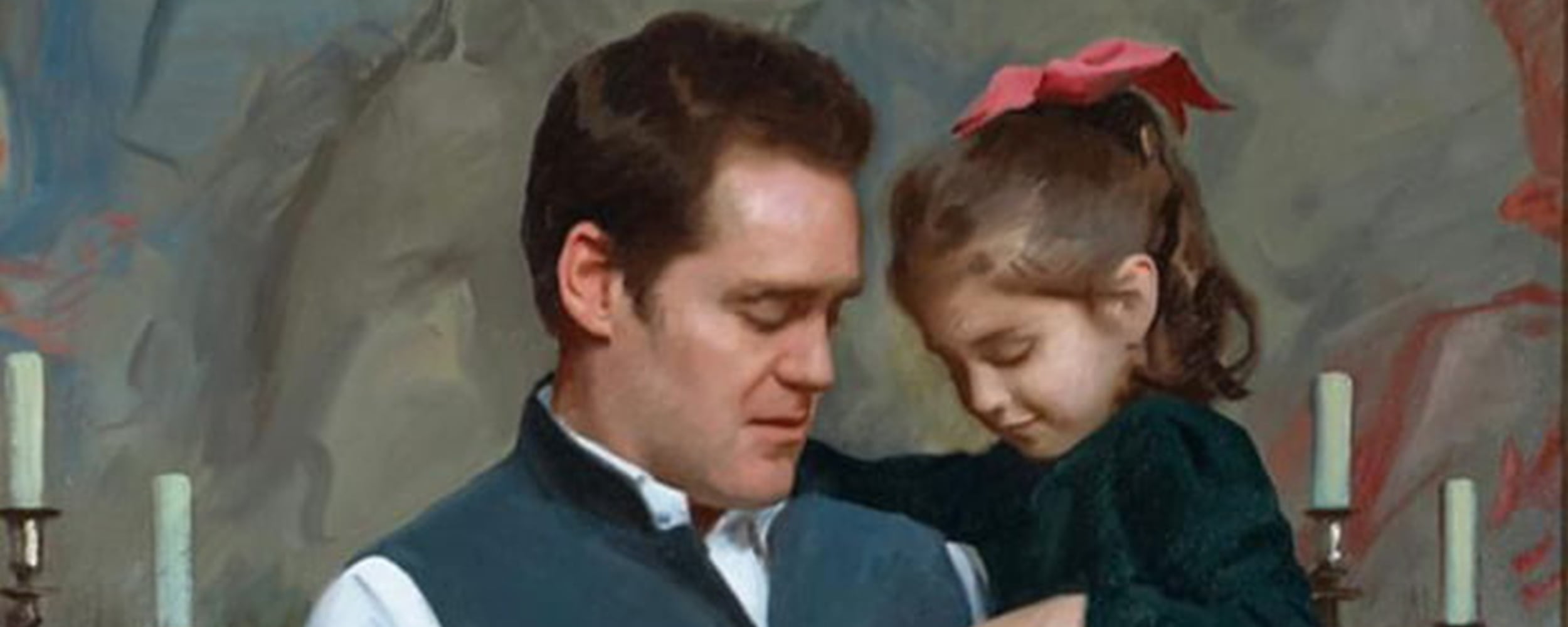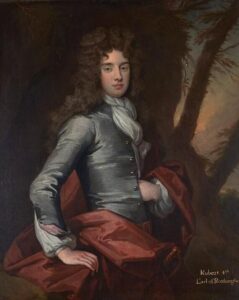It is possible that the Roxburghe family blood line in Britain began with two brothers, Ralph and John, originally from Normandy, who passed from England into Scotland in the 13th century. This laid the foundations for the two houses, the descendants of Ralph, the Ker line, Marquesses of Lothian, and the descendants of John being the Kers of Cessford.

There is a Henry Ker, who granted a letter of protection for himself and a retinue of 12 men from Edward III, in 1363. It is in this period that the name of Ker is listed as being associated with the barony of Auldtounburn. In the early part of the 15th century, the Kers are associated with the Earls of Douglas, the most prominent family in the region until their fall from grace in the middle part of the century.
Though the family can trace its lineage back to the High Middle Ages, family history pertinent to Floors Castle begins with the 5th Earl of Roxburgh, who was made the 1st Duke in 1707. It is useful, for context however, to also consider the line of Earls that began in the early part of the 17th century, to chart the rise of the family from prominent Border Reivers, to major players on the national stage.
1st Earl of Roxburghe, Robert Ker of Cessford (1570-1650)
The eldest son of William Ker of Cessford, Warden of the Scottish Middle March, Robert was one of the most colourful characters to inhabit the Borders during the reiving period. George McDonald Fraser’s account of Ker’s career pulls no punches, but reflects the region in the time in which Ker lived, describing him as, ‘a fierce, fearless and proud Border callant who, although he normally acted as Warden in his father’s place, was as practised a reiver as any on the frontier. “Ambitious, proud, bloody in revenge, poor and easily framed to any purpose”, was how a contemporary described him’. Fraser goes on to conclude, in summary of the reiving period that, ‘the good man survives, if he is lucky, the villain becomes the first Lord Roxburgh’, in a time of lawlessness and villainy, Robert Ker stood out. It was Robert Ker’s father who benefitted from the dissolution of the estates of Kelso Abbey in 1580, greatly expanding the family land holdings.
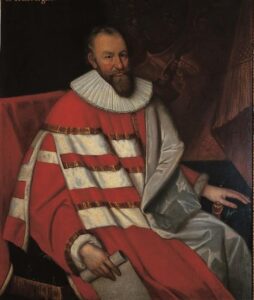 From an early age, Ker was learning the trade of raid, robbery and fighting for a living. His first recorded activity was when he was fifteen and he participated in a raid on Stirling. Two years later, he was a leader, along with the Bold Buccleuch and Lord Johnstone, at the head of 2,000 men in a raid against the Collingwoods. This raid so displeased King James, that he forbade Ker from marrying Mary, the daughter of Maitland of Lethington. Ker married her anyway, and ended up in jail as a result. This marriage produced three children, a son, who died in 1618, and two daughters, the eldest married the 2nd Earl of Perth.
From an early age, Ker was learning the trade of raid, robbery and fighting for a living. His first recorded activity was when he was fifteen and he participated in a raid on Stirling. Two years later, he was a leader, along with the Bold Buccleuch and Lord Johnstone, at the head of 2,000 men in a raid against the Collingwoods. This raid so displeased King James, that he forbade Ker from marrying Mary, the daughter of Maitland of Lethington. Ker married her anyway, and ended up in jail as a result. This marriage produced three children, a son, who died in 1618, and two daughters, the eldest married the 2nd Earl of Perth.
He was knighted in 1590, and fled Scotland after his plot to murder one of the Ancrum Kerrs was revealed. His possessions were forfeited as a result, though he was pardoned in 1591. The feud with the Ancrum Kerrs was to continue for another sixteen years. His talents were put to use in 1593, when he was made Deputy Keeper of Liddesdale, he also began assisting his father with his duties as Warden. This did not hamper his raiding activities. In 1595, he was at Wooler with eight riders, and killed three men. He then hopped over the border, looking for trouble, but finding none spent his time socialising and drinking in ‘enemy territory’.
His elevation to the king’s Privy Council coincided with a feud with the Turnbulls, several murders and much theft, not bad for a man of twenty-five. By 1597, he was credited with sixteen killings, and he and the Bold Buccleuch had cost the English Marches some £60,000. His campaign of disruption, murder and destruction was briefly arrested in 1598, when he was imprisoned by English Warden, Sir Robert Carey. The relationship between the two, so volatile in previous years, softened to the degree that Carey eventually considered Ker a friend; it seems that Ker was as charming as he was dangerous.
He was created Lord Roxburgh in 1600, and accompanied King James to London in 1603 when he assumed the English throne. James made him Earl of Roxburgh in 1616. He was Keeper of the Privy Seal between 1637 and 1649, and took up the cause of Charles I at the outbreak of Civil War in 1642.
His second marriage, to Jean Drummond, produced a son who predeceased his father. It was from this line that the fifth Duke of Roxburgh eventually came. His eventual successor, who inherited due to a special arrangement with Parliament, was William Drummond (later Ker), Robert’s grandson from his first daughter’s marriage to the Earl of Perth.
2nd Earl of Roxburghe, William Drummond (Later Ker) 1622-1675
The 2nd Earl of Roxburghe married his cousin, Jane Ker c.1655,the daughter of Harry, Lord Ker and Margaret Hay. He was knighted after 1648, and made a Privy Counsellor in 1660. He was also Colonel of the Roxburgh and Selkirk Militia in 1668.
3rd Earl of Roxburghe, Robert Ker (d.1682)
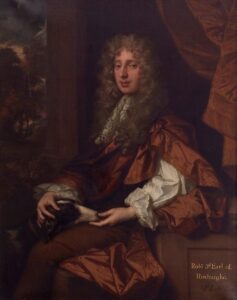 The 3rd Earl of Roxburghe was made a Privy Counsellor in 1680, to Charles II and Sherriff Principal in Selkirk the following year. He was also Sherriff of Roxburghshire and Baillie of the Regality of Melrose.
The 3rd Earl of Roxburghe was made a Privy Counsellor in 1680, to Charles II and Sherriff Principal in Selkirk the following year. He was also Sherriff of Roxburghshire and Baillie of the Regality of Melrose.
In May 1682, HMS Gloucester, a 50 gun third rate frigate, hit a sand bar off Yarmouth on the Norfolk coast in a gale. The ship’s rudder was shattered and the hull was holed. On board were the king’s brother, the Duke of York (the future James II), and John Churchill, future Duke of Marlborough. The accompanying fleet managed to dispatch boats to rescue many of the crew, along with York and Churchill. Robert, 3rd Earl of Roxburghe drowned, along with Sir John Hope of Hopetoun and 120 men of the crew.
5th Earl/1st Duke of Roxburghe, John Ker (1680-1741)
Inheriting his title on the death of his brother Robert in 1696, John Ker was described by some as, ‘the best accomplished young man of quality in Europe’. It was his fortunes that catapulted the family into the upper reaches of the aristocracy. He rose to be Secretary of State for Scotland in 1704-05 and again from 1716-25. In 1707, was created Duke by Queen Anne for his efforts in the promotion of the Act of Union between the Parliaments of England and Scotland. He was rather pragmatic as to the reasons why he promoted the historic political union, ‘the motives will be trade with most, Hanover with some, ease and security with others, together with a general aversion to civil discords, intolerable poverty and the constant oppression of bad ministry’. The 1st Duke was a representative Peer for Scotland, as well as holding a number of other offices both on the Privy Council and as keeper of the Privy Seal of Scotland for George I. He served as Lord Lieutenant of Roxburghshire and Selkirkshire, as well as being made a Knight of the Garter.
Politically, he was a Whig, and a supporter of the Hanoverian succession, he was appointed one of the Regents of Great Britain prior to the accession of George I in 1714, and supported the Crown in the Jacobite rising of the following year. He was an opponent of de facto first British Prime Minister Robert Walpole, who saw Roxburghe as something of a rabble rouser who had persuaded the 1st Duke of Montrose to resign his post as Secretary of State for Scotland before applying for the post himself.
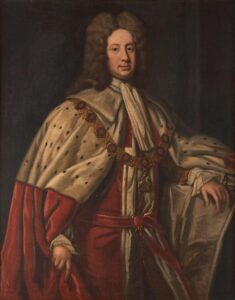 In common with many wealthy men of the early Enlightenment period, Roxburghe had a love of learning and moved in learned circles. He was made a Fellow of the Royal Society in 1707. He was a friend of Sir Isaac Newton (1642-1727), acting as a pall-bearer at his funeral. He was also friends with novelist and dramatist Henry Fielding (1707-1754) and Architect Royal Sir John Vanbrugh (1664-1726). It may have been Vanbrugh, the man responsible for the design of Castle Howard (Yorks) and Blenheim Palace (Oxfordshire) who initially sketched Roxburghe as a design for his own country house. It was the first duke that commissioned William Adam to create the original building at Floors in 1721.
In common with many wealthy men of the early Enlightenment period, Roxburghe had a love of learning and moved in learned circles. He was made a Fellow of the Royal Society in 1707. He was a friend of Sir Isaac Newton (1642-1727), acting as a pall-bearer at his funeral. He was also friends with novelist and dramatist Henry Fielding (1707-1754) and Architect Royal Sir John Vanbrugh (1664-1726). It may have been Vanbrugh, the man responsible for the design of Castle Howard (Yorks) and Blenheim Palace (Oxfordshire) who initially sketched Roxburghe as a design for his own country house. It was the first duke that commissioned William Adam to create the original building at Floors in 1721.
He married Mary Saville nee Finch, widow of William Saville, 2nd Marquess of Halifax, in 1708. She was the only child of Daniel Finch, 2nd Earl of Winchelsea and Lady Essex Rich, daughter and co-heiress of the 3rd Earl of Warwick. The two paintings by Flemish artist Peter Tillemans hanging in the Entrance Hall, are both properties that were seats of the 1st Duchess’ family, Burley on the Hill (Rutland) and Eastwell Park (Kent).
He was first interred in the family vault at Bowden Kirk, and later re-interred in the Roxburghe Ailse attached to Kelso Abbey. Their only child was Robert, Lord Ker, who inherited the dukedom on his father’s death in 1741.
2nd Duke Roxburghe, Robert Ker (c.1709-1755)
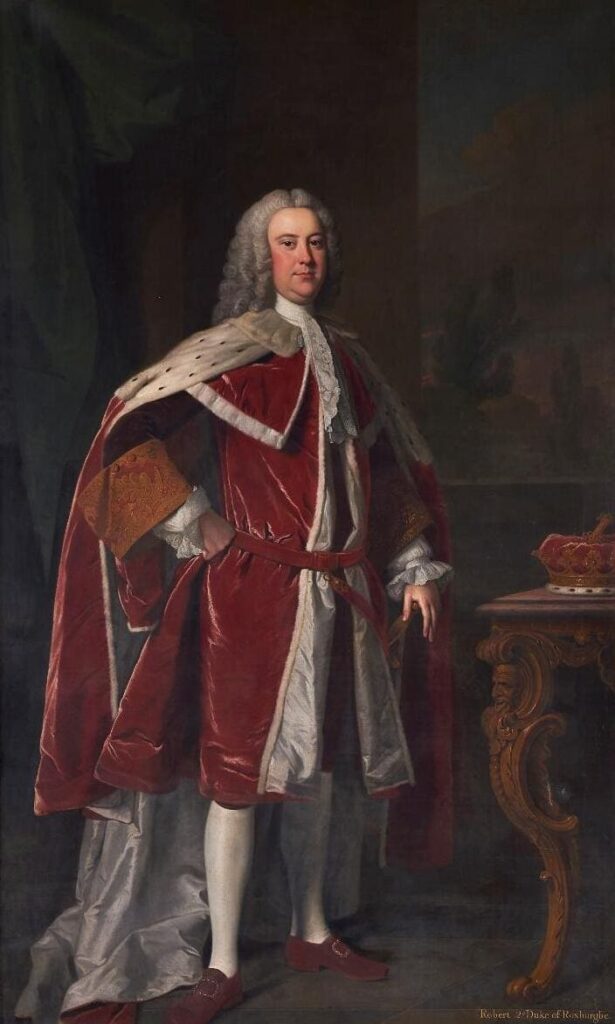 Inheriting the title on the death of his father in 1741, information on the second duke is not as readily available as for other members of the family.
Inheriting the title on the death of his father in 1741, information on the second duke is not as readily available as for other members of the family.
In 1722 he was created Baron and Earl Ker of Wakefield (Yorks), making him a Peer both north and south of the border, and bringing with it a seat in the House of Lords. He seemingly obtained the rank of Commodore in the fledgling U.S Navy.
In 1739 he married his half cousin Essex Mostyn, together they had five children. John, their first son, was born in 1740, and was to succeed his Father as the 3rd duke in 1755. Sadly, their first daughter, Essex, died in infancy in 1742, but was followed by two more daughters, Essex and Mary. The girls were Bridesmaids at the marriage of George III to Charlotte of Mecklenburg-Strelitz in 1761. A portrait of the two girls, by English artist Thomas Hudson, hangs in the Ante Room. A second son, Robert, was born in 1747 and seemingly had a military career, obtaining the rank of Lieutenant Colonel in the 6th Dragoons. It was during the time of the 2nd duke that alterations were made to the roofline at Floors, making it more elaborate.
3rd Duke Roxburghe, John Ker (1740-1804)
Born at Hannover Square in London, and taking up his responsibilities as duke at the tender age of fifteen, John Ker was educated at Eton. He is the subject of the magnificent painting in the Entrance Hall by Italian artist Pompeo Batoni. This picture was painted when the young duke was on the Grand Tour in 1761. This was the year that he first met Christina Sophia Albertina, the eldest daughter of the Duke of Mecklenburg-Strelitz. Christina’s younger sister Charlotte was to marry George III later that year. Not only was it against the grain socially for an older sister to marry a lower ranked man than her younger sibling, but court etiquette decreed that an older princess should not be the subject of a younger sister. Christina and John were thus precluded from marrying one another. It seems that they pledged themselves to celibacy (though this seems unlikely), they certainly never married. The duke focussed his romantic energies on the collecting of books instead of the pursuit of princesses. While in Italy, Ker saw a first edition of Boccaccio’s Decameron, often called the Valdarfers edition. This was a fabled book, which many said did not exist. He paid 100 guineas for it and showed it to his friends in London to huge acclaim. For the next 40 years he collected ancient and curious books, particularly editions of Shakespeare’s works and other works which merely mentioned Shakespeare. At his death in 1804 there were 10,000 items. Most were books, but there were also pamphlets and broadside ballad sheets.
His close relationship with sovereign and fellow bibliophile George III, brought influence at Court, He was a Lord of the Bedchamber from 1767, rising to the primary rank of Groom of the Stole in 1796. He acted as a Privy Counsellor, and was created a Knight of the Order of the Thistle in 1768, and elected to the Garter in 1801. Like his grandfather, he served as Lord Lieutenant of Roxburghshire between 1794 and 1804.
The third duke passed away without issue in 1804, meaning that the British peerages of Earl and Baron Ker of Wakefield became extinct.
4th Duke Roxburghe, William Drummond, 7th Lord Bellenden of Broughton (c.1728-1805)
With the 3rd duke dying childless, the title passed to his closest living male relative, a descendant of the younger son of the 2nd Earl of Roxburghe. William Drummond, who succeeded his cousin as 7th Lord Bellenden in 1796, was in his late seventies, and also childless, when he came into his Roxburghe inheritance in 1804.
The son of Lieutenant Colonel Hon. William Bellenden and Jacomina Farmer, he had himself served in the army, obtaining the relatively lowly rank of Captain in the 25th Foot. As mentioned above, despite two previous marriages, he was childless, and died in 1805, aged 77, soon after inheriting the ducal title. This caused something of a problem for the succession…
On the death of the 4th Duke of Roxburghe the whole male line descended from the 2nd Earl of Roxburghe failed and the Lordship of Bellenden became extinct. His nominated heir was his cousin’s son, John Gawler, whose father (also named John Gawler) is the subject of the portrait by Joshua Reynolds in the Ante Room. Although Gawler changed his name to Ker and was living in the castle, along with the dowager Duchess and ageing and unmarried sisters of the 3rd duke, his claim was not substantiated and was contested by four main parties:
(1) Lady Essex Ker, as heir of line of the 2nd Earl of Roxburghe
(2) Major General Walter Ker of Littledean, as heir male of the 1st Earl of Roxburghe
(3) Rt Hon William Drummond of Logiealmond, as heir male of the 2nd Earl of Roxburghe
(4) Sir James Norcliffe-Innes of that Ilk, 6th Bt., as heir male of the body of Margaret Ker, 3rd daughter of Harry,Lord Ker (d.1642)
Let it suffice to say that a long legal battle ensued, fought in the Scottish Court of Session and the House of Lords. Even the King got involved. Ultimately, the Lord Chancellor’s decision, after seven years and a fortune in legal fees, came in favour of the 76 year old Sir James Innes in 1812.
5th Duke Roxburghe, James Innes-Ker (1736-1823)
Succeeding his father as 6th Baronet of Innes in 1762, in his younger years he had served in the army in both the 88th and 58th Regiments of Foot. James Innes-Ker’s first wife, Mary Wray, had passed away in the opening salvoes of the legal battle over the Roxburghe titles in 1807. To fund his legal triumph, he was obliged to sell the library amassed by the 3rd duke at a famous auction held in 1812. At 76 years old, he was in a bit of a pickle dynastically, as his marriage to his late wife had produced no children. Salvation was provided through his second marriage to Harriet Charlewood, 42 years his junior, the same year his first wife passed. In July of 1816, with the duke aged 80, she produced a son, named James for his father, and the succession was assured.
Locally known as the ‘Good Duke James’, he was known for his endowments in Kelso, including the Town House, Roxburgh School and the Church Hall. He served as a Representative Peer for Scotland between 1818 and 1820. He died in 1823 in Genoa, aged 87, before being brought home and buried at Bowden Kirk.
6th Duke Roxburghe, James Henry Robert Innes- Ker (1816-1879)
Coming into his inheritance at the tender age of seven, following the death of his father in 1823, the young duke was raised at Floors by his mother, Harriet, and from 1827, by her second husband, Lieutenant Colonel Walter Frederick O’Reilly. He was educated at Eton, and then Christ Church College, Oxford. He was a lover of music, who had a reputation for kindness amongst his tenants.
In 1837, he was created Earl Innes, giving him a seat in the House of Lords. This was the first peerage to be created by the young Queen Victoria, who was to visit the Borders, and stay at Floors, in 1867. It was the 6th duke who employed famous architect William Playfair to make significant alterations and extensions to Floors over the decade 1837-47. It is to Playfair and the 6th duke that we owe the iconic façade and great size of the house as it now stands.
He was made a Knight of the Thistle in 1840, was Lieutenant General of the Royal Company of Archers (since 1822, and the visit of George IV, a ceremonial unit that acts as the Sovereign’s bodyguard in Scotland), and Lord Lieutenant of Berwickshire between 1873 and 1879. He also served as governor of the Bank of England.
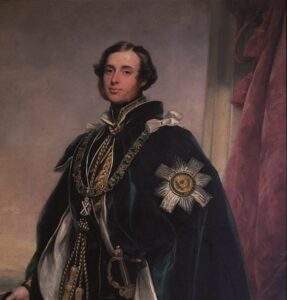 In the last days of 1836, he married Susannah Stephanie Dalbiac. As Duchess of Roxburghe, she became, in Queen Victoria’s own words, a ‘dear and valued friend’. In 1865, Victoria made her a Lady of the Bedchamber, and conferred upon her the Royal Order of Victoria and Albert. She was evidently a trusted member of the Royal Household, and was present at the attempted assassination of the queen in 1882 by Scotsman Roderick Maclean. She served as acting Mistress of the Robes from 1892 until her death in 1895. Her portrait by Samuel Mackenzie (1785-1847) hangs in the Billiard Room.
In the last days of 1836, he married Susannah Stephanie Dalbiac. As Duchess of Roxburghe, she became, in Queen Victoria’s own words, a ‘dear and valued friend’. In 1865, Victoria made her a Lady of the Bedchamber, and conferred upon her the Royal Order of Victoria and Albert. She was evidently a trusted member of the Royal Household, and was present at the attempted assassination of the queen in 1882 by Scotsman Roderick Maclean. She served as acting Mistress of the Robes from 1892 until her death in 1895. Her portrait by Samuel Mackenzie (1785-1847) hangs in the Billiard Room.
In 1879, the duke was returning home from a trip to Naples when he died in Geneva. His portrait (Scottish School, 1840) hangs in the Duke’s Dining Room. He and Susanna had four children, all of whom are on the walls of the Billiard Room, James, who succeeded him as the 7th Duke, Charles (b.1842), Susan (b.1837) and Charlotte (b.1841).
7th Duke Roxburghe, James Henry Robert Innes-Ker (1839-1892)
He was born on 5 September 1839 at Floors, to James Henry Robert Innes-Ker, 6th Duke of Roxburghe and Susanna Dalbiac, Duchess of Roxburghe, only child of Sir Charles Dalbiac. His mother was one of Queen Victoria’s staff until she died in 1895. His elder sister was Lady Susan Harriet Innes-Ker (1837-1909).
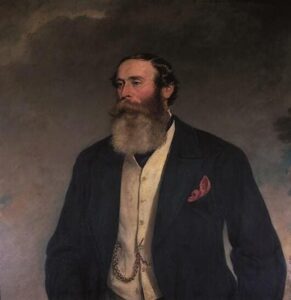 His younger siblings were Lady Charlotte Isabella Innes-Ker (1841-1881) and Lord Charles John Innes-Ker (b. 1842). He was educated firstly at Eton, and then at Christ Church College, Oxford, where he graduated with a Master of Arts.
His younger siblings were Lady Charlotte Isabella Innes-Ker (1841-1881) and Lord Charles John Innes-Ker (b. 1842). He was educated firstly at Eton, and then at Christ Church College, Oxford, where he graduated with a Master of Arts.
He served as Liberal Member of Parliament for Roxburghshire from 1870 to 1874, and was Lord Lieutenant of Roxburghshire from 1884 to his death in 1892, as well as being admitted to the Royal Company of Archers.
On 11 June 1874 he married Anne Emily Spencer-Churchill, daughter of the 7th Duke of Marlborough, together they had seven children. As Duchess of Roxburghe, she served as Mistress of the Robes to Queen Victoria between 1883 and 1885.
The 7th Duke is buried at Kelso Abbey.
8th Duke Roxburghe, Henry Innes-Ker (1876-1932)
The 8th Duke attended Eton College, and then the Royal Military College at Sandhurst. He began his military career in 1895, gaining the rank of 2nd Lieutenant in the 4th Battalion, Argyll and Sutherland Highlanders. He was a first cousin of Winston Churchill by virtue of his father’s marriage to the Duke of Marlborough’s sister. Following his graduation from Sandhurst, he became a Lieutenant in the Royal Regiment of Horse Guards (The Blues). He remained with the Household Cavalry, embarking with his regiment for South Africa. In 1901, he was appointed ADC to the Duke of Cornwall and York (the future George V) during the Second Boer War, and they developed a firm friendship. He served with distinction, and performed a heroic action in rescuing one of his troopers, who had been wounded and fallen from his horse, by turning back in the face of the enemy and hauling the unfortunate man onto his own mount.
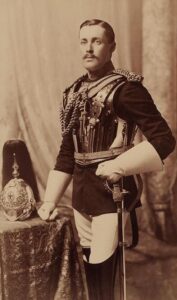 He became well established at Court, and moved in the most exclusive social circles on both sides of the Atlantic.
He became well established at Court, and moved in the most exclusive social circles on both sides of the Atlantic.
He was appointed member of the Royal Victorian Order 1901, and was granted the honour of carrying Queen Alexandra’s crown at the coronation the following year.
He became a member of the Order of the Thistle in 1902’s Coronation Honours list, being invested by Edward VII at Buckingham Palace later that year. He was to serve as Chancellor of the Order from 1928 until his death.
He married Mary Goelet (1878-1937) at St. Thomas’s Episcopal Church on 5th Avenue, New York in 1903.
It is the 8th Duke and his American duchess that are arguably the ones most responsible for the appearance of the interior of the house as it is today (at least the rooms that the public have access to!).
The advent of war in 1914 saw the duke back with his regiment. He was involved in the action at Roulers, in October 1914, the first German action on Belgian soil. He sustained a severe wound which put him out of action, and left him lame for the rest of his life. He was made Lord Lieutenant of Roxburghshire in 1918, and Lieutenant of the Royal Company of Archers in 1930. He died in 1932 and was interred in the new Roxburghe sepulchre within the cloister of Kelso Abbey.
9th Duke Roxburghe, George Innes-Ker (1913-1974)
George Victor Robert John Innes-Ker, 9th Duke of Roxburghe was born on 7 September 1913. Educated at Eton and subsequently, Sandhurst. He was a godson of George V and Queen Mary, a keen sportsman and a notable figure in local affairs. Like his Father before him, he served in the Blues, and saw action in the Middle East during the Second World War.
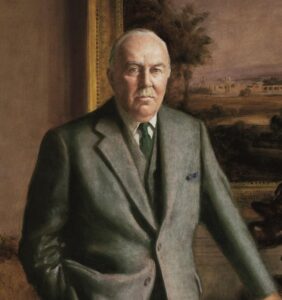 Following the war, he was involved in business and became convenor of the County Council.
Following the war, he was involved in business and became convenor of the County Council.
He married, firstly, Lady Mary Evelyn Hungerford Crewe-Milnes in 1935 in Westminster Abbey, they were divorced in 1953. He married, secondly, Margaret Elisabeth McConnel, on 5 January 1954.
He was admitted to the Royal Company of Archers and eventually gained the rank of Lieutenant. He held the office of Deputy Lieutenant of Roxburghshire. He also held the office of Justice of the Peace for Roxburghshire.
He died on 26 September 1974 at age 61 and is buried in Kelso Abbey.
10th Duke of Roxburghe, Guy Innes-Ker (1954-2019)
Guy David Innes Ker, the 10th Duke of Roxburghe was born on 18th November 1954. His mother Elizabeth McConnel was the 9th Duke’s second wife. Educated at Eton, he deferred his place at Magdalene College Cambridge to join the Blues and Royals, the regiment of his Father and Grandfather. He inherited the title in 1974 at the age of just 19 while serving in Cyprus. He had won the Sword of Honour months earlier as the top officer cadet of his intake at Sandhurst.
Guy Roxburghe completed his army career in 1977 following active service in Northern Ireland. He met his first wife Lady Jane Grosvenor, the daughter of the Duke of Westminster, while serving in Northern Ireland and they married in 1977 and had three children, Lady Rosanagh (born 1979), Charles, now 11th Duke of Roxburghe, (born 1981) and Lord Edward (born 1984). The marriage was dissolved in 1990.
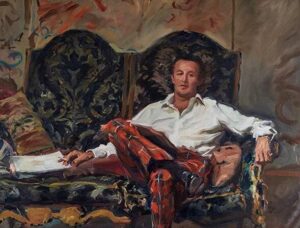 Guy Roxburghe brought determined practicality and considerable personal charm to managing these issues. At his death the estate was professionalised and diversified to encompass farming, forestry, commercial sport, bloodstock, tourism, renewable energy and property management.
Guy Roxburghe brought determined practicality and considerable personal charm to managing these issues. At his death the estate was professionalised and diversified to encompass farming, forestry, commercial sport, bloodstock, tourism, renewable energy and property management.
He opened Floors Castle to the public in 1977. The gardens were expanded and visitor numbers soared after the Hollywood movie Greystoke: The Legend of Tarzan was filmed at Floors Castle in 1984.
Guy Roxburghe’s energies were considerable and found many outlets. These included his greatest love; flat racing and breeding – he was the most successful Scottish thoroughbred breeder of modern times; the preservation of The Tweed River and its fisheries; efforts to sustain the local economy and communities in the borders, and the raising of large sums for charity.
Guy Roxburghe married his second wife, the interior designer Virginia Wynn-Williams, in 1992. There were two further children: Lady Isabella (born 1994) and Lord George (born 1996).
He was a long serving horse racing administrator with the Jockey Club, chaired the British Horse Racing Authority disciplinary board and became Chairman of the National Stud in 2017. He also held directorships in the City of London and was a Liveryman of the Worshipful Company of Fishmongers and a Freeman of the City of London.
The Duke had a long term interest in renewable energy and was one of the first historic house owners to install a biomass heating system using wood chips from the estate. In 2001 he began exploring wind farming on his land. The Fallago Rig Wind Farm, built in 2013 in partnership with North British Wind Power, feeds 80,000 homes.
In 2009 the Duke was diagnosed with cancer of the oesophagus. He fought and beat the disease with steely resolve. He subsequently raised more than £1.3million with the former Sotheby’s chairman Henry Wyndham in support of the Orbis Flying Eye Hospital and a cancer research project at Brunel University. The cancer returned in 2019 and he died on 29 August.

